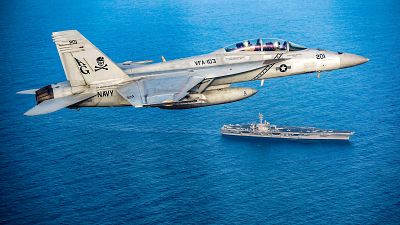Since the U.S. moved an aircraft carrier, Patriot missiles, and B-52 bomber task force to the region, Iran has pulled back some ships, but U.S. officials hesitate to say it is drawing down.
ABOARD THE USS ABRAHAM LINCOLN IN THE NORTH ARABIAN SEA — In early May, the Iranians and their proxies were at extremely high levels of military readiness with ships, submarines, surface-to-air missiles and drones all prepared, according to two U.S. officials in the region.Now, on Saturday, Gen. Frank McKenzie, commander of the U.S. Central Command, said that the U.S.'s moving the USS Abraham Lincoln, an aircraft carrier, plus Patriot missiles and a B-52 bomber task force to the region has had a stabilizing effect on Iran.McKenzie said this week that the threat is imminent and that Iran or its proxies could attack at any time.On Saturday, he expanded on that view, saying, "I would say the threat has probably evolved in certain ways."The Iranians have pulled back some of their ships in the area, but U.S. officials are hesitant to say whether this movement is actually drawing down forces or if this is a period of Iran resetting its forces.
It's yet to be seen what the new normal is," said one U.S. official in the region.Iranians fast boats continue to operate in the region's waterways, according to Rear Adm. John Wade, the commander of the Strike Group on the USS Lincoln."Since we've been operating in the region, we've had several interactions with Iranians," Wade said. "To this point all have been safe and professional, meaning, the Iranians have done nothing to impede our maneuverability or acted in a way which required us to take defensive measures."McKenzie said equipment carried by the aircraft carrier allows officials to gauge the evolving threat."You're always working to build your awareness of what's going on. And what this carrier gives you is a lot of ways to do that, through patrolling through the sensors that the carrier brings, through the sensors that its aircraft carry and report back," McKenzie said. "So it just gives us great opportunities to see what's going on out there. And then of course the carrier is seen by potential opponents. And they have to weigh the enormous capabilities that are resident aboard this platform."












